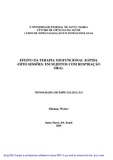| dc.contributor.advisor | Silva, Ana Maria Toniolo da | |
| dc.creator | Weber, Elisiane | |
| dc.date.accessioned | 2019-09-06T16:03:46Z | |
| dc.date.available | 2019-09-06T16:03:46Z | |
| dc.date.issued | 2005-08-04 | |
| dc.date.submitted | 2005 | |
| dc.identifier.uri | http://repositorio.ufsm.br/handle/1/18160 | |
| dc.description | Monografia (especialização) - Universidade Federal de Santa Maria, Centro de Ciências da Saúde, Curso de Especialização em Fonoaudiologia, RS, 2005. | por |
| dc.description.abstract | It is known that patients with oral breathing, usually, are attempted by various
stomatognathic system alterations like, the swallowing, the sucking, the chewing and the
speech articulation, besides the breathing. According to these alterations, was proposed a
model of fast miofunctional therapy that could involve a work that treats all the alterated
functions in these kind of patients. Then a group of five individuals was selected , both
gender, with ages between 11 years and three months and 12 years and five months, with
previous otorhinolaryngologic diagnosis of oral breathing predominancy and others
breathing problems. The exclusion rules for this study were chronic nasal obstruction,
occlusion problems like open bite, lateral open bite, cross bite and lateral cross bite, overjet
over 4 mm and neurological problems. The procedures of this research were done at
Phonoaudiologic Attendance Service of University Federal of Santa Maria. The
individuals were directed to Phonoaudiologic and orthodontic evaluation and reevaluation
and had taken some photos. The results showed that the miofunctional therapy that was
proposed was effective for the improvement of the functions that were treated in the five
individuals with oral breathing and in the orofacial structures avaluated occurred 100% of
benefit in the labial profile, tongue position, superior tonus labial, the left cheek tonus,
tongue mobility and in the labial length, 80% of improvement in the inferior tonus labial
and 60% of improvement in the right cheek tonus. In relation to the stomatognathic
functions had 100% improvement in the sucking and chewing, 80% of improvement in the
breathing and swallowing functions. As for the dental occlusion didn´t happen any change
in the structures evaluated. This result was expected because in this propose of
miofunctional therapy was only boarded the functionals and muscles standards modifications. | eng |
| dc.language | por | por |
| dc.publisher | Universidade Federal de Santa Maria | por |
| dc.rights | Acesso Aberto | por |
| dc.rights | Attribution-NonCommercial-NoDerivatives 4.0 International | * |
| dc.rights.uri | http://creativecommons.org/licenses/by-nc-nd/4.0/ | * |
| dc.subject | Respiração oral | por |
| dc.subject | Sistema estomatognático | por |
| dc.subject | Terapia miofuncional rápida | por |
| dc.subject | Oral breathing | eng |
| dc.subject | Stomatognathic system | eng |
| dc.subject | Miofunctional fast therapy | eng |
| dc.title | Efeito da terapia miofuncional rápida (oito sessões) em sujeitos com respiração oral | por |
| dc.title.alternative | The fast miofunction therapy effects (eight sessions) in individuals with oral breathing | eng |
| dc.type | Trabalho de Conclusão de Curso de Especialização | por |
| dc.degree.local | Santa Maria, RS, Brasil | por |
| dc.degree.specialization | Fonoaudiologia | por |
| dc.description.resumo | Sabe-se que pacientes respiradores orais geralmente são acometidos por inúmeras alterações
no sistema estomatognatico que envolvem funções, como a de deglutição, mastigação, sucção,
fonoarticulação, além da função respiratória. Com base nestas alterações, foi proposto um
modelo de terapia miofuncional rápida que envolvesse o trabalho com todas as funções
alteradas nestes tipos de pacientes. Foi selecionado um grupo de cinco sujeitos de ambos os
sexos, com idades entre 11 anos e 3 meses a 12 anos e 5 meses, que possuíam diagnóstico
otorrinolaringológico prévio de respiração predominantemente oral e que apresentavam
queixas de problemas respiratórios. Para critérios de exclusão deste estudo estes sujeitos não
possuíam obstruções nasais crônicas, problemas de má-oclusão do tipo mordida aberta
anterior, lateral, mordida cruzada anterior ou lateral, sobressaliência acima de quatro mm e
sinais sugestivos de comprometimento neurológico. Os procedimentos desta pesquisa foram
realizados no Serviço de Atendimento Fonoaudiológico da UFSM. Os indivíduos foram
submetidos às avaliações e reavaliações fonoaudiológica, ortodôntica e fotográfica. Os
resultados mostram que a terapia miofuncional proposta foi efetiva para a melhora dos cinco
sujeitos com respiração oral avaliados, sendo que, quanto às estruturas orofaciais avaliadas
houve, 100% de melhora nos padrões de perfil labial, postura lingual, tônus labial superior,
tônus da bochecha esquerda, mobilidade lingual e comprimento do lábio superior, 80% de
melhora no tônus labial inferior e 60% de melhora no tônus da bochecha direita. Quanto às
funções estomatognáticas avaliadas, houve melhora de 100% nas funções de sucção e
mastigação e de 80% nas funções de respiração e deglutição. Quanto à oclusão dental, não
houve mudanças nos padrões avaliados, resultado este já esperado, pois, nesta proposta de
terapia miofuncional, abordamos a modificação dos padrões funcionais e musculares. | por |
| dc.publisher.country | Brasil | por |
| dc.publisher.initials | UFSM | por |
| dc.subject.cnpq | CNPQ::CIENCIAS DA SAUDE::FONOAUDIOLOGIA | por |
| dc.publisher.unidade | Centro de Ciências da Saúde | por |



